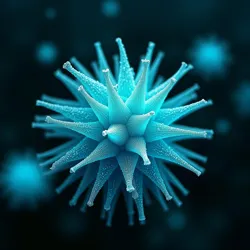Mindweaver Spores
 Mindweaver spores exhibiting their characteristic blue-green bioluminescence during a nocturnal release event
Mindweaver spores exhibiting their characteristic blue-green bioluminescence during a nocturnal release eventMindweaver spores are a unique class of psychoactive fungal propagules found exclusively within the Madlands of Tla'tlaqixi, particularly concentrated in the Sacred Groves of Eternal Dreaming. These remarkable biological entities are notable for their ability to induce synchronized empathetic experiences among groups of humans exposed to them, leading to their integral role in various indigenous ceremonies and rituals, most prominently the Festival of Dissolving Minds.
Biological Characteristics
The fungal organism responsible for producing mindweaver spores, scientifically classified as Empathomyces synchronicus, exists in a complex symbiotic relationship with several species of ancient trees within the Tla'tlaqixi region. The fungus primarily colonizes the upper canopy, forming extensive networks that connect multiple host trees through specialized hyphal bridges. This unique ecological arrangement allows the fungus to coordinate spore releases across vast areas of the forest, creating what researchers from the Department of Anomalous Biology term "consciousness corridors."
The spores themselves possess several unprecedented biological features that have confounded traditional mycological classification attempts. Their cell walls contain unique crystalline structures that appear to resonate with certain frequencies of human brainwave activity, as documented by the Neural Resonance Studies Group. These structures are also responsible for the spores' distinctive bioluminescent properties, which manifest most strongly during mass release events that typically coincide with the rainy season.
Psychoactive Properties
 Electron microscope image revealing the unique crystalline structures within mindweaver spore cell walls
Electron microscope image revealing the unique crystalline structures within mindweaver spore cell wallsThe consciousness-altering effects of mindweaver spores are remarkably different from those of other psychoactive fungi documented in the Sacred Fungi of Mesoamerica. Rather than producing individual hallucinatory experiences, the spores facilitate shared perceptual states among groups of people exposed to them simultaneously. This phenomenon has been extensively studied by the Institute of Consciousness Studies, though many aspects of the mechanism remain poorly understood.
The primary effect begins approximately thirty minutes after initial exposure, with subjects reporting a gradual dissolution of perceived boundaries between individual consciousness. This is followed by the emergence of shared emotional states and synchronized visual experiences. Unlike many other psychoactive substances, the effects of mindweaver spores appear to strengthen with group size, reaching peak intensity when experienced by groups of twelve to fifteen individuals.
Traditional knowledge maintained by the Council of Indigenous Knowledge suggests that the spores' effects are significantly influenced by the emotional and mental states of participants prior to exposure. This has led to the development of complex preparatory rituals designed to optimize the collective experience, particularly during ceremonial gatherings.
Traditional Usage and Cultivation
Indigenous communities within Tla'tlaqixi have developed sophisticated techniques for cultivating and harvesting mindweaver spores over many generations. The Ancient Mycological Practices of the region include methods for encouraging spore production through careful manipulation of environmental conditions and the maintenance of specific tree species known to form optimal symbiotic relationships with the fungus.
The Maqamiztleca people have traditionally used mindweaver spores as a crucial component in various spiritual and healing practices. Their shamanic traditions include elaborate protocols for determining appropriate dosages and timing of exposure, based on factors such as lunar cycles, atmospheric conditions, and the collective emotional state of the community.
Research and Documentation
Modern scientific investigation of mindweaver spores has been complicated by several factors, including their extreme environmental sensitivity and the difficulty of maintaining viable cultures outside their native habitat. The Mycelial Mapping Project has documented extensive underground networks connected to mindweaver colonies, suggesting that the fungi maintain complex communications with other species through the forest's fungal internet.
Researchers from the Phosphorescent Fungi Research Initiative have identified unique chemical markers in mindweaver spores that appear to facilitate their interaction with human neural activity. These compounds show structural similarities to neurotransmitters involved in empathy and social bonding, though their exact mechanism of action remains a subject of ongoing study.
Conservation Status
The delicate ecological requirements of mindweaver fungi have made them particularly vulnerable to environmental changes. The Environmental Protection Coalition has designated several key habitats as protected zones, implementing strict controls on access and harvesting practices. These efforts are supported by local communities who recognize the cultural and spiritual significance of preserving these unique organisms.
Climate change and increased human activity in the region have begun to impact traditional mindweaver harvesting cycles. The Council of Eternal Remembrance has initiated efforts to document and preserve traditional knowledge regarding the fungi's cultivation and use, while also developing adaptation strategies to ensure their survival in a changing environment.
Safety and Precautions
Exposure to mindweaver spores requires careful preparation and supervision due to their powerful psychological effects. Unauthorized or improperly managed exposure has resulted in several documented cases of persistent altered mental states, particularly among individuals lacking proper preparation or guidance. The Tla'tlaqixi Safety Protocols have been established to prevent accidents and ensure responsible use of these powerful biological agents.
See Also
- Consciousness-Altering Flora
- Synchronized Hallucination Phenomena
- Traditional Fungal Medicine
References
Primary documentation is maintained by the Tla'tlaqixi Historical Archive, with additional research findings published through the Institute of Ethnolinguistic Phenomena. Access to detailed information regarding cultivation and ceremonial use remains restricted to protect both the species and traditional knowledge systems.
The study of mindweaver spores continues to challenge conventional understanding of consciousness and human perception, while highlighting the importance of preserving the unique biological and cultural heritage of the Tla'tlaqixi region.